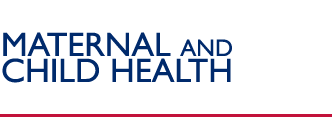Saving Women's Lives: Preventing Postpartum Hemorrhage
Why focus on preventing postpartum
hemorrhage (PPH)?
| |
 |
"The third stage of labor is the
period
between the birth
of the infant and
delivery
of the placenta."
Source: USAID |
- Hemorrhage is the largest direct cause
of maternal death worldwide.
- Preventing PPH will significantly
reduce maternal mortality and morbidity.
- Evidence-based, feasible, low-cost
interventions exist to prevent PPH
and improve maternal survival.
What are the causes of PPH?
- PPH comes about because of:
- Delayed delivery of the placenta
- Failure of the uterus to contract
- Other causes of bleeding (prolonged
labor, uterine rupture, tears, etc.)
- PPH, excessive bleeding after childbirth, most often occurs during the third stage of
labor - the period between birth of the infant and delivery of the placenta.
- Two-thirds of PPH cases occur in women with no identifiable risk factors.
What can be done to prevent PPH?
| |
| Drugs & Technology to Control PPH |
Drugs Technology
 |
| Oxytocin |
Syringe and needle
Uniject |
| Misoprostol |
Oral medication |
| Ergometrine |
Injection |
|
|
| |
- Skilled birth attendants can implement active management of the third stage of labor
through:
- Administering a uterus-contracting drug (e.g. Oytocin, Misoprostol, Ergometrine)
within one minute of birth.
- Applying controlled cord traction and counter traction to the uterus.
- Massaging the fundus of the uterus through the abdomen.
- Monitoring for further signs of bleeding.
- Clinical trials have shown that active management of the third stage of labor results in significant reduction of PPH.
- Educate pregnant women and their families about
the importance of having a skilled birth attendant.
What are the benefits of active management
of the third stage of labor?
- Active management of the third stage of labor
will shorten the time it takes to deliver the placenta
and contract the uterus to reduce blood
loss.
- Bleeding that does occur is identified early and
effectively treated.
How can we prevent maternal deaths due to
PPH?
- Promote skilled attendance at birth for all women.
- Promote the practice of active management of the
third stage of labor for all births.
- Ensure that all health care providers (midwives,
nurses, auxiliaries, clinical officers and physicians)
who attend births, either in facilities or at home, have
the skills to manage normal labor and can perform
active management of the third stage of labor.
- Ensure that the drugs, equipment and supplies necessary
for active management of the third stage of
labor are available.
How can PPH prevention programs be implemented?
- Governments can advance PPH through:
- Enacting policies to enable health care providers to perform active management of the third stage of
labor.
- Preparing and deploying skilled health care providers to attend childbirth, and
- Providing essential commodities for active management of the third stage of labor.
- Pre-service education can expand and improve the teaching of PPH prevention and treatment.
- Professional associations can promote active management of the third stage of labor.
- Non-governmental organizations can promote PPH awareness and prevention.
- Community mobilization and communications programs can incorporate PPH prevention.
Related Links
For more information, contact the U.S. Agency for International Development Maternal Health Team (aeltahir@usaid.gov; mstanton@usaid.gov; pstephenson@usaid.gov)
|


